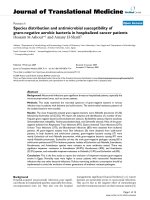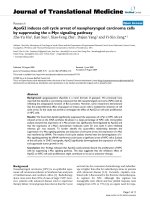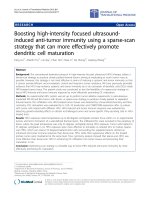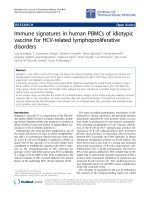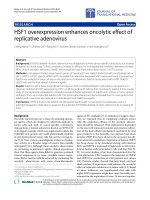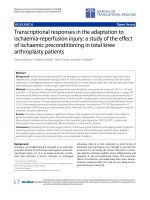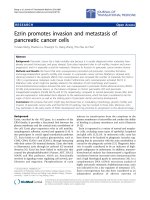Báo cáo hóa học: " Lower extremity fatigue increases complexity of postural control during a single-legged stance" potx
Bạn đang xem bản rút gọn của tài liệu. Xem và tải ngay bản đầy đủ của tài liệu tại đây (1.29 MB, 10 trang )
RESEARCH Open Access
Lower extremity fatigue increases complexity of
postural control during a single-legged stance
Stephen J McGregor
1*
, W Jeffrey Armstrong
2
, James A Yaggie
3
, Erik M Bollt
4
, Rana Parshad
4
, Jerry J Bailey
2
,
Sean M Johnson
2
, Aleta M Goin
2
and Samuel R Kelly
2
Abstract
Background: Non-linear approaches to assessment of postural control can provide insight that compliment linear
approaches. Control entropy (CE) is a recently developed statistical tool from non-linear dynam ical systems used to
assess the complexity of non-stationary signals. We have previously used CE of high resolution accelerometry in
running to show decreased complexity with exhaustive exercise. The purpose of this study was to determine if
complexity of postural control decreases following fatiguing exercise using CE.
Methods: Ten subjects (5 M/5 F; 25 ± 3 yr; 169.4 ± 11.7 cm; 79.0 ± 16.9 kg) consented to participation approved
by Western Oregon University IRB and completed two trials separated by 2-7 days. Trials consisted of two single-
legged balance tests separated by two Wingate anaerobic tests (WAnT; PreFat/PostFat), or rest period (PreRest/
PostRest). Balance tests consisted of a series of five single-legged stances, separated by 30 s rest, performed while
standing on the dominant leg for 15-s with the participant crossing the arms over the chest and flexing the non-
dominant knee to 90 degrees. High resolution accelerometers (HRA) were fixed superficial to L3/L4 at the
approximate center of mass (COM). Triaxial signals from the HRA were streamed in real time at 625 Hz. COM
accelerations were recorded in g’s for vertical (VT), medial/lateral (ML), and anterior/posterior (AP) axes. A newly
developed statistic (R-test) was applied to group response shapes generated by Karhunen Loeve (KL) transform
modes resulting from Control Entropy (CE) analysis.
Results: R-tests showed a significant mean vector difference (p < .05) within conditions, between axes in all cases,
except PostFat, indicating the shape of the complexity response was different in these cases. R-test between
conditions, within axis, differences were only present in PostFat for AP vs. PreFat (p < .05). T-tests showed a
significantly higher overall CE PostFat in VT and ML compared to PreFat and PostRest (p < .0001). PostFat CE was
also higher than PostRest in AP (p < .0001).
Conclusions: These data indicate that fatiguing exercise eliminates the differential complexity response between
axes, but increases complexity in all axes compared to the non-fatigued condition. This has implications with
regard to the effects of fatigue on strategies of the control system to maintain postural control.
Background
Balance, or postural stability, is the net result of the
forces acting on the body’ s center-of-mass (COM)
within the base of support. Blaszczyk and co-workers
(1994) state that the ranges of the postural limits define
the perimeters of stability and represent the maximum
amount of excursion the COM may incur without fall-
ing. Impairment of the musculoskeletal and sensory
systems involved in postural control is of clinical impor-
tance when characterizing the outcomes and precautions
for the avoidance of traumatic injury and fall. A clini-
cally/physiologically relevant way that postural control
can be impaire d is through fatiguing exercise [1,2]. Yag-
gie and McGregor [1] observed that fatigue of the ankle
plantar and dorsi-flexors resulted in si gnificant, but
transient, changes in sway parameters and ranges of
postur al control. Because impaired postural control may
have implications for subsequent traumatic injury in
sport and recreation [3], it is important to characterize
how fatigue induced in different muscle groups, or via
* Correspondence:
1
School of HPHP, Eastern Michigan University, Ypsilanti, MI, USA
Full list of author information is available at the end of the article
McGregor et al. Journal of NeuroEngineering and Rehabilitation 2011, 8:43
/>JNER
JOURNAL OF NEUROENGINEERING
AND REHABILITATION
© 2011 McGregor et al; licensee BioMed Central Ltd. This is an Open Access article distributed under the terms of the Creative
Commons Attribution License (http://cr eativecommons.org/licenses/by/2.0), which permits unrestricted use, distribution, and
reproduction in any medium, provided the original work is properly cited.
different modalities affect s the nature of impairments to
postural control. In the case of the Yaggie and McGre-
gor [1] study, the fatigue was induced through isokinetic
exercise localized to small muscle groups primarily act-
ing on the ankle joint (e.g. ankle dorsi and plantarflex-
ors). Isokinetic exercise is not common in athletic or
recreational endeavors. Further, many exercise modal-
ities involve larger muscle groups that may be acting on
joints “upstream” from the ankle joint. Therefore, it is of
interest to examine the impact of more dynamic exer-
cise affecting larger, more disparate muscle groups
involved in postural control.
Multiple tools have been employed to a ssess balance
and posture. Forceplates have been used to assess move-
ment of the center-of-foot-pressure (COFP). According
to Adlerton and others [4], this approach may have l im-
ited sensitivity in capturing the subtle changes asso-
ciated with postural control as COFP provides only the
summation of control mechanisms and provides no
information pertinent to the discrete muscle actions that
lead to postural control. Trunk accelerometry using a
high-resolution accelerometer (HRA) mounted on the
body at the approximate center of mass (COM) can pro-
vide an alternative or complement to forceplates in bal-
ance studies [4-6]. Accepti ng that the body moves as an
inverted pendulum in erect posture, COM accelerations/
velocities reflect postural sway, and thereby provide a
useful compliment or alternative to COFP. This metho-
dology has been supported by Moe-Nilssen and Helbos-
tad [6] and has been demonstrated to be reliable [5].
Further, since HRA of COM measures the actual move-
ment of the approximate COM, it can be argued this is
a more reflective measure of the intended output (pos-
ture) of the controller than COP measures using fore-
cplates, which are effectively weighted averages of forces
applied diffusely over the contact surface being
measured.
Typically, postural control is evaluated using tradi-
tional linear analytical approaches. Recently though,
there has been increasing interest in the use of non-lin-
ear analytical techniques derived from the field of dyna-
mical systems [7]. In particular, the use of complexity/
regularity statistics such as Approximate and Sample
Entropy have provided new insight into the nature of
postural control, and its impairment due to traumatic
brain injury [3]. A major limitation to the use of most
non-linear approaches, though, is the requirement of
stationarity, which limits the utility of these tools under
dynamic condition s. Recently, Bollt et al. [8] have devel-
oped a novel approach to comple xity analysis termed
ControlEntropy,which,importantly,alleviatesthe
requirement of stationarity. This tool has been used to
demonstrate distinctive constraints between different
planes of movement in runners [9] as well as between
groups of trained versus untrained runners [10]. As
there are numerous differences between Control
Entropy (CE) and ot her complexity statistics (e.g.
Approximate Entropy; ApEn, [8], and CE is more appro-
priate for use under dynamic conditions, CE may pro-
vide additional insight regarding impairment of postura l
control that can complement information that is already
available.
The purposes of the present study were to evaluate
the effect of dynamic, large muscle mass fatiguing exer-
cise on i) changes in COM accelerations and ii) the
complexity of these signals as assessed w ith CE. To
achieve these aims, we used a standard bicycle exercise
protocol, the Wingate Anaerobic Test (WAnT), which is
objectively quantifiable and well characterized with
regard the n ature of the fatigue it imparts on subjects.
Further, we applied a recently developed, novel statisti-
cal approach, termed the R-test [10], for the rigorous
comparison of within group and between group CE
measures. We hypothesized that after fatiguing large
muscle mass exercise of the lower limbs that i) COM
accelerations would be increased relative to the control
condition and ii) CE of the HRA signal would decline
indicating reduced complexity and/or increased con-
straints of postural control.
Methods
Subjects
Ten participants (5 males and 5 females ; mean age = 25
± 3 yr; height = 169.4 ± 11.7 cm; weight = 79.0 ± 16.9
kg) were recruited, and consented to participation
throughcompletionoftheWesternOregonUniversity
IRB approved informed consent documentation in
accordance with the Declaration of Helsinki. All partici-
pants indicated by self-reported medical history that
they had no known physiological or functional condi-
tions that would prohibit them from performing exhaus-
tive exercise for a brief period of time, and had no
known, recent, or previous injuries that would prevent
them from participating.
The participants reported to the Exercise Physiology
Laboratory having at least 2-hours rest from exercise
and 12-hour abstention from alcohol, caffeine, and any
medication that affects the central nervous system. Test-
ing days were separated by no more than seven days.
One-legged Stances
A series of five single-legged stances were repeated twice
during each of two testing days to record HRA mea-
sures for the purposes of assessing balance. Thus, four
sets of five stances were grouped as follows: Pre-Rest
(PreRest), Post-Rest (PostRest), Pre-Fatigue (PreFat), and
Post-Fatigue (PostFat). Stances were performed while
standing on the dominant leg (determined by the leg
McGregor et al. Journal of NeuroEngineering and Rehabilitation 2011, 8:43
/>Page 2 of 10
with which the participant would instinctively kick a
ball) for 15-seconds with the participant crossing the
arms over the chest and flexing the non-dominant knee
to 90 degrees. Each stance in a set was separated by a
30-s rest period.
COM Acceleration
A wireless HRA (G-Link, ± 10 g, MicroStrain, Inc., Will-
iston, VT) was fixed with two-sided tape at the intersec-
tion of the sagittal and axial planes on the posterior
trunk superficial to L3/L4, at the a pproximate center of
mass [5] and secured with elastic tape (PowerFlex, And-
over, MA). Triaxial signals from the HRA were streamed
in real time to a b ase station at a frequency of 625 Hz
and then exported to AcqKnowledge 4.0 (Biopac Sys-
tems, Inc., Santa Barbara, CA) for analysis. COM acce l-
erations were recorded in g’s for vertical (VT), medial/
lateral (ML), and anterior/posterior (AP) axes. Reliability
of these procedures has been demonstrated to be mod-
erately strong (r = 0.63-0.89) and is discussed in a pre-
vious publication [11].
Statistical Analysis
RM-ANOVAs were used to analyze the effects of fati-
gue. Bonferroni post hoc analyses were subsequently
performed to determine group differences where
applicable. All linear statistical analyses were per-
formed using PASW statistical software v. 17.0 (SPSS
Inc., a ≤ 0.05). Control Entropy, K-L a nalysis and R
tests were performed using Matlab (The Mathworks,
MA; a ≤ 0.05).
Control entropy and Statistical Testing
From an information theory standpoint, the Shannon
entropy [2], is defined as
SE = −
p
i
ln
p
i
(1)
where p
i
is the probability of being in a state i. Many
variants of this are actively used in the dynamical sys-
tems literature [12-14]. Recently much attention has
been drawn to the approximate entropy (AE) of Pincus
[15,16]. An essential requirement of this method, is an
inherent assumption of stationarity. In [8] we developed
a regularity statistic termed control entropy (CE). This
is an entropy-like statistic, that could apply to non-sta-
tionary time series data. Non-stationarity is observed in
a large number of real world processes, and thus
requires the usage of a tool such as (CE). Furthermor e
part of our goal was to understand parameter changes
within the system as a way of detecting developing pro-
blems, or to serve as a warning before system failure.
The (CE) tool is well suited for this. We define the con-
trol entropy of the signal,
CE
j+J,w,{z
i
}
n
i=1
,m,r,T
=SE(j+J,w,{z
i
− z
i−1
}
n
i=1
,m,r,T)),for0 ≤ j ≤ n − w.
(2)
We adopt the SAX m ethod here and b is chosen to
consist of n symbols, and xi is mappe d to si according
to an equipartition of Z-values from a normal model on
thedataset.WeshallusetheSAXsymbolizationin
computing CE according to Eq. (2), where n will be cho-
sen to satisfy the saturation criterion which we
described in [8].
Our curren t goal i s to ad opt a for mal statistical
approach to continue the agend a of [8]. We would now
like to construct something stronger than the “ellipsoid”
approach, which is essentially a proper orthogonal
decomposition of the CE signal, and then consideration
of the first two modes. Thus we want to decide with a
statistical confidence, how different two groups of bal-
ance conditions might be. We will resort to multivari ate
statistical analysis as we are considering the first two
modes. Under the assumption of normality, we are deal-
ing with a projective data cloud, and choose to use the
Hotelling’s T
2
test, [5]. This is a multivariate version of
the students t test. The students t distribution is a con-
tinuous probability distribution that arises when one
wants to estimate the mean of a normally distributed
population. It is used when the sample size is small,
[17]. In the multivariate setting we have vector observa-
tions, as a result of the POD routine applied to the CE
signal of the raw data from the subjects.
X
1i
=
x
11
x
12
Y
1i
=
y
11
y
12
(3)
Here X
1i
represents a particular subject in say the first
group with x
11
and x
12
the first two modes. Similarly
there are X
2i
,X
3i
, X
ni
and Y
2i
,Y
3i
X
ni
for the two dif-
ferent groups under consideration. Thus, we have that
μ
1
is the population mean vector for the first group and
μ
2
is the population mean vector for the second group.
We are interested in testing the null hypothesis that the
population mean vectors for the two groups of subjects
are equal, against the alternat ive hypothesis that these
mean vectors are not equal. This can be carried out via
the following procedure. Under the null hypothesis the
two mean vectors are equal element by element. Thus
we will look at the differences between the observations.
We define
Z
i
=X
1i
− Y
1i
(4)
We also define the vector
µ
z
= µ
1
− µ
2
(5)
Thus, we have now converted our original problem
into a problem of testing the null hypothesis that the
population mean vector μ
z
= 0. This hypothesis is tested
McGregor et al. Journal of NeuroEngineering and Rehabilitation 2011, 8:43
/>Page 3 of 10
using the paired Hotelling’s T
2
test. We reject the null
hypothesis at level a if the F-value exceeds the value
with p and n-p degrees of freedom, evaluated at level a,
which for our purposes (as well as in most cases) is set
at 0.05. The computations for the above were carried
out in MATLAB. We developed code to symbolize the
raw data, from which the CE is calculated. This is
passed into a second routine which performs the POD,
and yields the domina nt modes, for subjects for the
groups in question. This is finally passed pair wise, into
a routine that carries out the multivariate Hotelling
T
2
test, yielding the statistics of interest, which essentially
allows us to compare the groups. For details the reader
is referred to [10].
Results
Mean peak-peak amplitudes for HRA are presented in
Table 1. RM-A NOVA revealed no significant effects for
time × session × axis (p = 0.99) and time × axis (p=
0.40). There were significant effects for time, session,
and time × session (p < 0.001). Post hoc analyses con-
firmed no differences between resting measures and a
significant effect of fatigue (p ≤ 0.003).
Control Entropy of HRA: Mean Vector Differences (R-test)
between Axes
Results of the R-test for PreFat condition between axes
can be found in Table 2. Mean vector differences were
significant between all axes within this condition. Simi-
larly, the PostRest condition resulted in significant Mean
Vector differences between all axes, and the PreRest
Mean Vector differences were significant between VT vs
ML and ML vs AP, and a trend (p = 0.11) for VT vs AP
was present. No Mean Vector differences were present
for the PostFat condition between axes.
Control Entropy of HRA: PreFat vs. PostFat by Axis
Compariso n of the K-L dominant modes in the VT axis
for PreFat vs. PostFat can be seen in Figure 1. The R-
test showed no statistical d ifference (Table 3) between
shapes of the PreFat and PostFat conditions, but a t-test
showed a significant difference (Table 3) in overall CE
between conditions indicating that CE was generally
lower in the PreFat condition vs. the PostFat condition
in the VT axis. Further, the PostRest condition was also
significantly lower than PostFat in the VT axis.
Comparison of the K-L dominant modes in the ML
axis for PreFat vs. PostFat can be seen in Figure 2. The
R-test showed no statistical difference, but a trend
(Table 3) between shapes of the PreFat and PostFat con-
ditions. Also, a t-test showed a significant difference
(Table 3) in overall CE between conditions indicating
that CE was generally lower in the PreFat condition vs.
the PostFat condition in the ML axis. As with the VT
axis, the PostRest condition was also significantly lower
than PostFat in the ML axis.
Comparison of the K-L dominant modes in the AP
axis for PreFat vs. PostFat can be seen in Figure 3. The
R-test showed a highly significant difference, (Table 3)
between shapes of the PreFat and PostFat conditions.
Because of the significantl y different shape of the domi-
nantmodesinthisaxis,itwasnotappropriatetoper-
form a t-test to quantify differences in absolute CE
values between the two conditions. No significant differ-
ence was observed between the shapes of PostRest and
PostFatbyvirtueoftheR-Test, therefore a t-test was
performed and CE of the PostRest conditi on was gener-
ally lower than the PostFat condition in the AP axis.
Discussion
In this study, we present a novel approach to investigate
the effects of lower limb fatigue on both the linear mea-
sures, as well as the complexity (i.e. r egularity) of
Table 1 Mean peak-peak amplitudes for and HRA (g)
PreRest PostRest PreFat PostFat
Vertical (VT) 0.074 ± 0.026 0.069 ± 0.022 0.074 ± 0.025 0.128 ± 0.050*
Medial-Lateral (ML) 0.101 ± 0.038 0.098 ± 0.033 0.102 ± 0.038 0.153 ± 0.650*
Anterior-Posterior (AP) 0.074 ± 0.020 0.073 ± 0.023 0.071 ± 0.026 0.099 ± 0.032*
Resultant (RES) 0.072 ± 0.025 0.067 ± 0.020 0.089 ± 0.066 0.187 ± 0.251*
*significantly greater than resting conditions (PreRest, PostRest, and PreFat), p ≤ 0.003.
Table 2 Within Treatment Effects
Mean Vector Differences for CE of
HRA
VT vs
ML
ML vs
AP
VT vs
AP
PreRest 0.020 0.014 0.110
PostRest 0.004 < 0.000 0.040
PreFat 0.001 < 0.000 0.030
PostFat 0.450 0.130 0.180
Mean Differences for CE of HRA VT vs
ML
ML vs
AP
VT vs
AP
PreRest NA NA 0.914
PostRest NA NA NA
PreFat NA NA NA
PostFat 0.560 0.930 0.480
McGregor et al. Journal of NeuroEngineering and Rehabilitation 2011, 8:43
/>Page 4 of 10
postural control. Complexity was evaluated through
assessment of Control Entropy of COM- HRA signal,
and a novel statistical approach was used for this pur-
pose. From a linear perspective, it was hypothesized that
fatiguing lower limb exercise would result in greater
COM accelerations during one-legged stance compared
to the control condition. This was indeed the case as
there was a significant effect for fatigu e on COM accel-
erations during one-legged stance. With regard to non-
linear aspects of the study, it was hypothesized that
fatiguing lower limb exercise would increase the con-
straints on the components of control of posture, as evi-
denced by reduced CE. Contrary to this hypothesis,
changes in CE with fatiguing exercise indicated
increased complexity of postural control. The implica-
tions of this novel insight are discussed herein.
Fatigue and linear characteristics of postural control
The effects of fatigue on the maintenance of postural
control mechanisms have been well documented
[1,4,6,18]. Previously, we have reported differences in
sway parameters and balance indices immediately post-
fatigue utilizing both gen eralized lower extremity exer-
cise (WanTs) [18], as well as localized ankle isokinetics
[1]. Further, Alderton, Moritz and Moe-Nilssen [4]
investigated the relationship between forceplate and tri-
axial accelerometer measures of the one-legged stance
pre- and post-fatigue. Force plate analysis of center-of-
pressure velocity and amplitude in the M/L and A/P
were observed, while similar directional observations
were recorded using a tri-axial accelerometer. The
results showed significant increa se in trunk acceleration
and center-of-pressure amplitude in both directions and
a significant decrease in center-of-pressure velocity in
both directions, indicating that the foot may have been
Figure 1 Dominant modes of K-L analysis performed on Control Entropy outputs of HRA signal of the VT axis collected during single-
legged stance for PreFat (White) and PostFat (Red). Shape of the dominant modes is not significantly different. Mean of PostFat significantly
higher than PreFat (p < 0.001). Yellow lines indicate beginning and end of single legged stance tests.
Table 3 Between Treatment Effects
Mean Vector Differences for CE of
HRA
VT ML AP
PreRest vs. PostRest 0.989 0.808 0.851
PostRest vs. PostFat 0.185 0.212 0.058
PreFat vs. PostFat 0.256 0.059 <
0.0000
Mean Differences for CE of HRA VT ML AP
PreRest vs. PostRest 8.6^-30 9.8^-32 2.1^-27
PostRest vs. PostFat 3.0^-14 1.1^-21 8.3^-22
PreFat vs. PostFat 1.4^-
232
7.1^-
256
NA
In all cases of significant values for Mean Differences, PostRest was greater
than PreRest and Post Fat was greater than Post Rest and PreFat
McGregor et al. Journal of NeuroEngineering and Rehabilitation 2011, 8:43
/>Page 5 of 10
in a more secure posture, while the trunk oscillated to
stabilize the perturbations in stance. Further analysis
concluded that there was a moderate correlation
between force plate center-of-pressure measurements
and trunk accelerometer accelerations. The investigators
concluded that trunk accelerometry may be a more
appropriate measure for changes occurring at the hip
and trunk and may provide an alternate facet of kine-
matic analysis that kinetics may not detect. In the pre-
sent study, RM-MANOVA rev eal ed differences in all of
linear HRA values (AP, VT, ML, RES), post-fatigue, and
the directional analyses are consistent with the previous
literature [4].
Linear changes in AP values were slight but significant
(Table 1). A possible explanation for these changes
includes the fact that under the fatigued condition, the
anterior orientation remains quite stable, likely due to
the ability of the visual system to attenuate mechanisms
of fatigue via visual awareness of self-to-object orienta-
tion. Further, the anterior projection of the forefoot
allows for a semi-rigid lever for steadiness and segmen-
tal correction. It is likely that the differences in the lin-
ear AP values are attributed to the more posterior
projection of the COM in maintenance of postu re post-
fatigue, and may also relate to the changes in vertical
accelerations observed, post exercise. As the muscula-
ture of the lower extremity becomes unresponsive in the
sensory and motor domains under fatigue, it relies more
heavily on the unfatigued trunk musculature to make a
rapid correction in stance. The increase in AP and VT
values are likely due to an increase in trunk extension
intended to mediate the alterations in body sway by
aligning the COM in a more erect posture. Spinal exten-
sion represents a conjugate motion in both the posterior
and vertically positive direction, supporting the present
observations.
ML corrections were also notable in the post-fatigue
condition. The significant increases in linear ML values
are consistent wit h the literature [4]. As the body begins
to sway post-fatigue, the small musculature of the lateral
leg compartment (peroneal muscles) fails to respond to
the demands placed on it by the COM excursion.
Therefore, the corrections are typically made more
superiorly in the kinetic chain at the level of the trunk.
Again, the unfatigued trunk musculature may contract
to more effectively correct posture and maintain stance.
The resultant acceleration of the COM, derived from
the HRA values, will represent the resolved vector for
all motion abou t the trunk noted in this condition. Each
axes of motion exhibited an increase in acceleration
Figure 2 Dominant modes of K-L analysis performed on Control Entropy outputs of HRA signal of the ML axis collected during single-
legged stance for PreFat (White) and PostFat (Red). Shape of the dominant modes is not significantly different (p = 0.059). Mean of PostFat
significantly higher than PreFat (p < 0.001). Yellow lines indicate beginning and end of single legged stance tests.
McGregor et al. Journal of NeuroEngineering and Rehabilitation 2011, 8:43
/>Page 6 of 10
following the WAnT trials. The linear RES HRA values,
in-turn, exhibited significant alteration post-fatigue.
These values provide a resolution of all directions of
motion observed over time. It is not surprising that the
significantly positive resolution of the AP, VT and ML
linear HRA values exhibited in the RES measure would
represent an increase in trunk (COM) excursion post-
fatigue.
Fatigue and complexity of postural control
Although much of the linear HRA responses were
anticipated, and agreed with the literature or stated
hypotheses; in contrast, it was not anticipated that fati-
guing lower limb exercise would elicit an increase in CE
of COM accelerations. In general, relatively high entropy
indicates high complexity/low constraints, and on the
other hand, low entropy indicates low complexity/high
constraints [8]. In the current work, we hypothesized
that fatiguing exercise of the lower limbs would result
in increased constraints imposed upon postural control,
and this would be evidenced by reduced CE of HRA sig-
nal in the PostF at condition, but this was not the case.
In all conditions where comparison of mean CE between
conditions was appropriate, CE of the fatigued condition
(PostFat) was higher than either of the non-fatigued
conditions (PreFat and PostRest; Table 3). Further, in
the single case (AP; Table 3) where an R-test indicated
adifferentshapeoftheCEresponsewaselicitedbythe
fatigued condition (PostFat) relative to the non-fatigued
condition (PreFat), it appears as though the CE is higher
during fatigue than all other conditions (Figures 3 and
4). If the shapes of the dominant modes are not differ-
ent, then it follows that the time evolutions of the dyna-
mical characte ristics of the signals are not different and
thismaybeappropriatelytestedbyasimplemeans
comparison between two conditions. On the other hand,
if there is a significant difference in the shape of domi-
nant modes, the conclusion is that the time evolution of
the dynamical characteristics of the signal are signifi-
cantly different. Comparison of means between the two
conditions should be viewed with caution, and may be
entirely inappropriate.
The hypothesis that fatigue would elicit a reduction in
CE of HRA during balance tasks was stimulated by 1)
observations that Approximate Entropy (ApEn) of cen-
ter of pressure oscillations is reduced after concussion
[19] and 2) previous data using CE of HRA signal in
running where CE was reduced dramatically with fatigue
in all axes [9]. Since it had previously been reported that
complexity of postural control was reduced with
Figure 3 Dominant modes of K-L analysis performed on Control Entropy outputs of HRA signal of the AP axis collected during single-
legged stance for PreFat (White) and PostFat (Red). Shape of the dominant modes is significantly different (p < 0.001). Yellow lines indicate
beginning and end of single legged stance tests.
McGregor et al. Journal of NeuroEngineering and Rehabilitation 2011, 8:43
/>Page 7 of 10
concussion (increased constraint) and we had observed
decreased CE of HRA with exhaustion in running, it fol-
lowed that with exhaustion/fatigue of the lower limbs
with cycling, we would see reduced CE of signal asso-
ciated with postural control. This was not the case, but
it is not without precedent. Cavanaugh has also reported
using ApEn that complexity of balance increased with
the addition of a cognitive task [20], and Donker has
also reported that regularity of postural control i s
reduced (complexity increased) with the addition of a
cognitive task [7]. Therefore, it may be that in the c ase
of single leg balance and quiet stance, the induction of a
fatigued state of the muscles of the lower limb is more
akin to adding a cognitive task than to impaired postural
control resulting from acute brain injury. In particular
with regard to the Cavanaugh study, it is interesting to
note that with the addition of the cognitive task, com-
plexity only changed in the AP axis, and not th e ML. In
the current study, although we used a different
approach, that of the R-test of K-L transformations, the
only PostFat value that was different from PreFat was
the AP value, indicating a differential shape of the CE
response. Despite this, there were strong trends for dif-
ferent shapes of the K-L transforms for the ML axis
compared to PreFat, and for the AP axis compared to
PostRest (control). So, it appears a s though t he AP axis
is most susceptible to changes in the shape of the CE
response with fatigue . Despite this, all axes were signifi-
cantly higher for PostFat compared to PreFat and PostR-
est. Further, all axes were significantly higher in the
PostRest vs. PreRest condition. This indicates that there
is likely some adaptation in the short- term that results
in greater complexity in postural control with one famil-
iarization trial (PreRest), but that the increases in com-
plexity with fatigue are over and above those increases
that occur as a result of familiarization.
The increased complexity of postural control in the
PostFat condition may be analogous to the condition
reported by Donker et al. [7] with added “dual tasks”.In
the Donker work [7], adding a single cognitive task to
standing with eyes closed in healthy young subjects,
complexity decreased (reduced Sample Entropy), but if a
Figure 4 Dominant modes of K-L ana lysis performed on Control Entropy outputs of HRA signal of the a) VT, b) ML and c) AP axes
collected during single-legged stance for PreRest (Blue), PostRest (Green) PreFat (White) and PostFat (Red). Yellow circles indicate
segments where PostFat CE is apparently higher than in all other conditions.
McGregor et al. Journal of NeuroEngineering and Rehabilitation 2011, 8:43
/>Page 8 of 10
second cognitive task was added, complexity increased
relative to the single task condition. It should be noted
that in the Donker study, postural control was assessed
during two-legged standing, and the authors surmised
that two-legged standing while performing dual tasks
with eyes open was not challenging, but with eyes closed
and performing a single task, attention was diverted to
postural control and complexity declined, while adding
in the second task diverted attention away from postural
control, thus inc reasing complexity of the task. There-
fore, if we accept Donker’s assertion that increased com-
plexity of postural control is indicative of reduced/
diverted attention, we can interpret the current results
to indicate that 1) the “learning effect” of the post-Rest
condition results in reduced attention to the task of pos-
tural control and 2) the addition of fatigue results in
greater diversion of attention away from postural con-
trol than the learning effect itself. T he question arises
then, if fatigue causes attention to be diverted away
from the postur al control task, to where is the attent ion
diverted? Further work will be necessary to experimen-
tally address this question.
It is of interest to contrast the results of the current
study with previous results we have obtained performing
CE analysis of HRA during exhausting run tests.
Although not directly comparable with regard to the
role of attention on balance, comparing these results
eliminates potential confounding factors of data collec-
tion (e.g. force plates vs. HRA) and analysis (e.g.
Approximate Entropy vs. Sample Entropy vs. Control
Entropy). In other words, the differences in complexity/
regularity found between studies using different collec-
tion methods and, particularly regul arlity statistics, can-
not be attributed solely to biological factors. For
example, the technical differences between Approximate
Entropy, Sample Entropy and Control Entropy have
been addressed at length previously [8], and therefore,
factors such as partition number and or data stationarity
cannot be ruled out as sources of discrepancies in
results between studies using these techniques. In our
running work though, HRA data were colle cted and
analyzed similarly to the current study, and therefore
differences in the CE of HRA response should be attrib-
uted to the constraints imposed and the controller’ s
efforts to address them [8]. So, the fact that CE of HRA
signal declines at exhaustion during running contrasts
with the increased CE of HRA signal after fatiguing
exercise in the c urrent study. Is this difference due to
the differences in the nature of the tasks (i.e. single-
legged balance vs. running) or due to the constraints
imposed? Further work will be necessary to elucidate
this question. Additionally, future work should address
differences in data collection methods (i.e. force plate
vs. HRA) during the balance task following fatiguing
exercise. For example, performing CE analysis of force
plate and HRA data collected simultaneously will resolve
any discrepancies pre sent as a result of technical differ-
ences between data collection methods, while providing
additional insight regarding the differences in control
constraints in two different “local” dynamical environ-
ments (i.e. COM vs COFP).
Conclusions
We repo rt here that fatiguing exercise o f the lower
limbs affects both linear and non-linear characteristics
of postural control. Most notably, comple xity of pos-
tural control is increased following two successive
Wingate anaerobic tests. The underlying reason for
this increased complexity is not clear, but may be
because fatigue of lower limbs imparts an increased
requirement for attention to the balance task. Alterna-
tively, fatigued muscles may be ineffective at properly
implementing the controller’ s output commands,
hence requiring greater exploration of solutions to the
postural control problem in this state. Our statistical
approach allowed us to determine differences in com-
plexitythatwereduesimplytoalearningeffectas
opposed to those that were due to fatigue itself. These
results have clinical implications for the maintenance
of postural control and the prevention of traumatic
injury in the fatigued state, and provide a foundation
for future work in this area.
Acknowledgements
The authors would like to thank the subjects for their willingness to
participate in the study. We would also like to express our appreciation to
the reviewers for their efforts in evaluating the manuscript.
Author details
1
School of HPHP, Eastern Michigan University, Ypsilanti, MI, USA.
2
Division of
HPE, Western Oregon University, Monmouth, OR, USA.
3
College of Health
Professions, University of Findlay, Findlay, OH, USA.
4
Department of
Mathematics & Computer Science, Clarkson University, Potsdam, NY, USA.
Authors’ contributions
SJM, WJA, JAY participated in study design, data analysis and manuscript
preparation. EMB and RP performed data analysis and contributed to
manuscript preparation. JJB, SMJ, AMG and SRK participated in the design
and coordination of the data collection. All authors read and approved of
the final manuscript.
Competing interests
The authors declare that they have no competing interests.
Received: 15 November 2010 Accepted: 4 August 2011
Published: 4 August 2011
References
1. Yaggie JA, McGregor SJ: Effects of isokinetic ankle fatigue on the
maintenance of balance and postural limits. Arch Phys Med Rehabil 2002,
83:224-228.
2. Vieira Tde M, de Oliveira LF, Nadal J: An overview of age-related changes
in postural control during quiet standing tasks using classical and
modern stabilometric descriptors. J Electromyogr Kinesiol 2009, 19:
e513-519.
McGregor et al. Journal of NeuroEngineering and Rehabilitation 2011, 8:43
/>Page 9 of 10
3. Cavanaugh JT, Guskiewicz KM, Stergiou N: A nonlinear dynamic approach
for evaluating postural control: new directions for the management of
sport-related cerebral concussion. Sports Med 2005, 35:935-950.
4. Adlerton AK, Moritz U, Moe-Nilssen R: Forceplate and accelerometer
measures for evaluating the effect of muscle fatigue on postural control
during one-legged stance. Physiother Res Int 2003, 8:187-199.
5. Moe-Nilssen R: Test-retest reliability of trunk accelerometry during
standing and walking. Arch Phys Med Rehabil 1998, 79:1377-1385.
6. Moe-Nilssen R, Helbostad JL: Trunk accelerometry as a measure of
balance control during quiet standing. Gait Posture 2002, 16:60-68.
7. Donker SF, Roerdink M, Greven AJ, Beek PJ: Regularity of center-of-
pressure trajectories depends on the amount of attention invested in
postural control. Exp Brain Res 2007, 181:1-11.
8. Bollt EM, Skufca JD, McGregor SJ: Control Entropy: A Complexity Measure
for Nonstationary Signals. Mathematical Biosciences and Engineering 2009,
6:1-25.
9. McGregor SJ, Busa MA, Skufca J, Yaggie JA, Bollt EM: Control entropy
identifies differential changes in complexity of walking and running gait
patterns with increasing speed in highly trained runners. Chaos 2009,
19:026109.
10. Parshad R, Bollt E, Skufca J, McGregor S: A Novel Statistical Approach To
The Use of Control Entropy Identifies Differences in Constraints of Gait
in Highly Trained Versus Untrained Runners. Mathematical Biosciences and
Engineering 2011.
11. Armstrong WJ, McGregor SJ, Yaggie JA, Bailey JJ, Johnson SM, Goin AM,
Kelly SR: Reliability of mechanomyography and triaxial accelerometry in
the assessment of balance. J Electromyogr Kinesiol 20:726-731.
12. Cover TM, Thomas JA: Elements of Information Theory New York: Wiley-
Interscience New York; 2006.
13. Grassberger P, Procaccia I: Estimation of the Kolmogorov entropy from a
chaotic signal. Physical Review A 1983, 28:2591-2593.
14. Kantz H, Schreiber T: Nonlinear Time Series Analysis Cambridge: Cambridge
University Press; 2004.
15. Pincus SM: Approximate Entropy as a Measure of System Complexity.
Proceedings of the National Academy of Sciences of the United States of
America 1991, 88:2297-2301.
16. Pincus SM: Assessing Serial Irregularity and Its Implications for Health.
Annals of the New York Academy of Sciences 2001, 954:245.
17. Mardia K, Kent J, Bibby J: Multivariate Analysis. Multivariate Analysis 1979.
18. Yaggie J, Armstrong W: Effects of fatigue on indices of balance. Journal of
Sport Rehabilitation 2004,
13:312-322.
19. Cavanaugh JT, Guskiewicz KM, Giuliani C, Marshall S, Mercer V, Stergiou N:
Detecting altered postural control after cerebral concussion in athletes
with normal postural stability. Br J Sports Med 2005, 39:805-811.
20. Cavanaugh JT, Mercer VS, Stergiou N: Approximate entropy detects the
effect of a secondary cognitive task on postural control in healthy
young adults: a methodological report. J Neuroeng Rehabil 2007, 4:42.
doi:10.1186/1743-0003-8-43
Cite this article as: McGregor et al .: Lower extremity fatigue increases
complexity of postural control during a single-legged stance. Journal of
NeuroEngineering and Rehabilitation 2011 8:43.
Submit your next manuscript to BioMed Central
and take full advantage of:
• Convenient online submission
• Thorough peer review
• No space constraints or color figure charges
• Immediate publication on acceptance
• Inclusion in PubMed, CAS, Scopus and Google Scholar
• Research which is freely available for redistribution
Submit your manuscript at
www.biomedcentral.com/submit
McGregor et al. Journal of NeuroEngineering and Rehabilitation 2011, 8:43
/>Page 10 of 10

